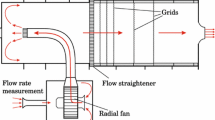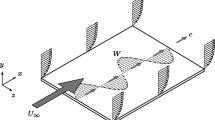Abstract
This work reports aerodynamic testing of two spanwise-oscillating surfaces fabricated out of electroactive polymers (EAPs) in the dielectric form of actuation, and of an electromagnetic-driven linear motor. Hot-wire and PIV measurements of velocity and direct measurement of friction drag using a drag balance are presented. A maximum of 16 % surface friction reduction, as calculated by the diminution of the wall-normal streamwise velocity gradient, was obtained. Among other quantities, the spatial dependence of the drag reduction was investigated. When this spatial transient and portions which are static are accounted for, the direct drag measurements complement the hot-wire data. PIV measurements, where the laser beam was parallel to the oscillating surface at y + ≈ 15, support the hot-wire data. The two actuators are original in design, and significant contributions have been made to the development of EAPs. This experiment is the first to aerodynamically test EAP actuators at such a large scale and at a relatively moderate Re.























Similar content being viewed by others
References
Akhavan R, Kamm R, Shapiro A (1991a) An investigation of transition to turbulence in bounded oscillatory Stokes flows Part 1. Exp J Fluid Mech 225:395–422
Akhavan R, Jung W, Mangiavacchi N (1993) Turbulence control in wall-bounded flows by spanwise oscillations. App Sci Res 51:299–303
Alfredsson PH, Örlü R (2010) The diagnostic plot—a litmus test for wall bounded turbulence data. Eur J Mechs B Fluids 42:403–406
Bradshaw P, Pontikos N (1985) Measurement in the turbulent boundary layer on an infinite-swept wing. J Fluid Mech 159:105–130
Choi K (2002) Near-wall structure of turbulent boundary layer with spanwise-wall oscillation. Phys Fluids 14(7):2530–2542
Choi K, Clayton B (2001) The mechanism of turbulent drag reduction with wall oscillation. Int J Heat Fluid Flow 22(1):1–9
Choi K, DeBisschop JR, Clayton B (1998) Turbulent boundary-layer control by means of spanwise-wall oscillation. AIAA J 36(7):1157–1163
Dearing S, Lambert S, Morrison J (2007) Flow control with active dimples. Aero J 111(1125):705–714
Dearing S, Morrison J, Iannucci L (2010) Electro-active polymer (EAP) dimple actuators for flow control: design and characterisation. Sens Actuators A Phys157:210–218
Du Y, Symeonidis V, Karniadakis G (2002) Drag reduction in wall-bounded turbulence via a transverse travelling wave. J Fluid Mech 457:1–34
Fernholz HH, Krause E, Nockemann M, Schober M (1995) Comparative measurements in the canonical boundary layer at Re δ2 < 6 × 104 on the wall of the DNW. Phys Fluids A 7:1275–1281
Gouder K (2011) Turbulent friction drag reduction using electroactive polymer surfaces. PhD thesis, Imperial College London
Il-Choi J, Xu C, Sung H (2002) Drag reduction by spanwise wall oscillation in wall-bounded turbulent flows. AIAA J 40(5):842–850
Jung W, Mangiavacchi N, R A (1992) Suppression of turbulence in wall-bounded flows by high-frequency spanwise oscillations. Phys Fluids A 4(8):1605–1607
Kamphuis J (1975) Friction factor under oscillatory waves. J Waterways, Port Coastal Engineering, Div ASCE 101:135–144
Kofod G (2001) Dielectric elastomer actuators. PhD thesis, The Technical University of Denmark
Laadhari F, Skandaji L, Morel R (1994) Turbulence reduction in a boundary layer by a local spanwise oscillating surface. Phys Fluids 6(10):3218–3220
Moffat R (1988) Describing the uncertainties in experimental results. Exp Therm Fluid Sci 1:3–17
Pelrine R, Kornbluh R, Joseph J, Chiba S (1997) Electrostriction of polymer films for microactuators. IEEE 0-7803-3744-1:238–243
Potter M, Gouder K, Morrison J (2011) A numerical model for electro-active polymer actuators with experimental validation. Sens Actuators A Phys 170:121–130
Quadrio M, Ricco P (2003) Initial response of a turbulent channel flow to spanwise oscillation of the walls. J Turb 4(007)
Quadrio M, Ricco P (2004) Critical assessment of turbulent drag reduction through spanwise wall oscillations. J Fluid Mech 521:251–271
Quadrio M, Sibilla S (2000) Numerical simulation of turbulent flow in a pipe oscillating around its axis. J Fluid Mech 424:217–241
Quadrio M, Viotti C (2007) Skin-friction drag reduction via steady streamwise oscillations of spanwise velocity. In: Palma JMLM, SilvaLopez A (eds) Advances in Turbulence. Springer, Berlin
Quadrio M, Ricco P, Viotti C (2009) Streamwise-travelling waves of spanwise wall velocity for turbulent drag reduction. J Fluid Mech 627:161–178
Ricco P, Wu S (2004) On the effects of lateral wall oscillations on a turbulent boundary layer. Exp Thermal Fluid Sci 29:41–52
Schlichting H (1968) Boundary layer theory, 6th edn. McGrawHill Book Company, New York
Schoppa W, Hussain F (1998) A large-scale control strategy for drag reduction in turbulent boundary layers. Phys Fluids 10(5):1049–1051
Zhao H, Wu JZ, Luo JS (2004) Turbulent drag reduction by travelling wave of flexible wall. Fluid Dyn Res 34:175–198
Acknowledgments
We would like to thank Mr. Anthony Oxlade for his assistance in PIV setup and associated data analysis. We would also like to thank Professor Maurizio Quadrio who kindly ran two DNS simulations specifically to be used in comparison with the results in this work. We would also like to thank EPSRC, Airbus and QinetiQ for their financial support.
Author information
Authors and Affiliations
Corresponding author
Additional information
This article is part of the collection Topics in Flow Control. Guest Editors J. P. Bonnet and L. Cattafesta.
Rights and permissions
About this article
Cite this article
Gouder, K., Potter, M. & Morrison, J.F. Turbulent friction drag reduction using electroactive polymer and electromagnetically driven surfaces. Exp Fluids 54, 1441 (2013). https://doi.org/10.1007/s00348-012-1441-y
Received:
Revised:
Accepted:
Published:
DOI: https://doi.org/10.1007/s00348-012-1441-y




